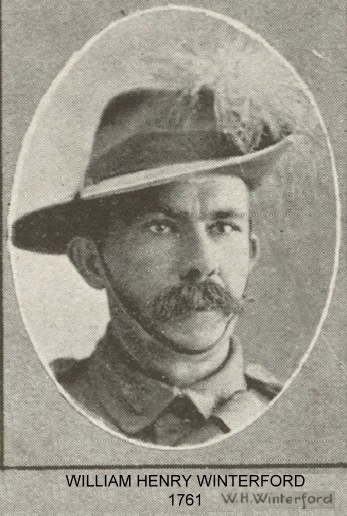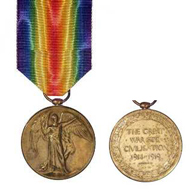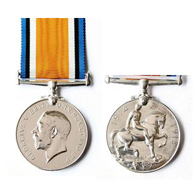WINTERFORD William Henry
-

- 1761
- Private
- trooper
- 5 Light Horse Regiment
- 12th Rifles
- Nambour
- Yes
- 1873
- beenleigh
- 18 January 1915
- HMAT SS Hawkes Bay
- 21 October 1915
- Sydney
-
William Henry Winterford, 5ft 10inches, bronze complexion, brown eyes and black hair, was born in Beenleigh, south of Brisbane in 1873. When he enlisted for the First World War in Rockhampton he declared that his occupation was "miner" - it appears though that he had been the licensee of the Royal Hotel in Nambour before that. He was 42 years of age when he enlisted and cited many different areas of service and experience on his enlistment papers. He had been a senior cadet for 11/2 years; a member of the Bisley Team ; a volunteer in Queensland Rifles for ten years; and a member of the English Rifle Club for three years. A search in Trove shows that he is mentioned frequently with good results at various shooting competitions around the Brisbane area. His enlistment papers also mentioned that he had been in SA fighting the Boer War for 10 months. There are few details of this service but we know that he joined the 2nd Queensland Mounted Infantry together with his brother, they were both living at the Clarence Hotel at the time, on 17/12/1899 and left on the "Moravian" for South Africa. He returned "invalided" on 23/10/1900 and was discharged on 30th October that year. The record of his service in the First World War omits all mention of battles fought or campaigns involved in - instead there is a long list of misdeameanours for which he was continually being punished. He was drunk in camp on 27/1/1916 and reduced to the rank of private.He was absent from parade on 19th January that year and forfeited all eight days pay. He went into hospital at Helouan on 3/2/1916 with a sprained wrist. In April 1916 he was transferred to the 5th Light Horse Brigade at Tel e Kebir. In August he was admitted to hospital in Port Said and a letter was dispatched to his father advising him of his sons "mild illness". He was several times in hospital between then and September 1917, first for otitis, and then diagnosed with neurasthenia. There are notes in his medical file that he was at Moascar, Rafa, Inaraheb, Abbassia, Ghezerich and Port Said. The Medical Board classified his neuritis as "B2" in February 1918 and in May it was reclassified as "A". In June 1919 he was committed of a crime" Insolence to an officer" after he had been awol from 20.30 till 21.40 one evening. I can only imagine that this grown man found military life in his forties very difficult and went on a bender every now and again. And he must have been in many battles and skirmishes - he was overseas for a period of three complete years and seven months. SO although his history of in and out of hospital is a long list, he was away from home for longer than anyone else I have researched. He was sent home on 118th July 1919 from Suez due to "debility". He arrived home on 18/8/1919 and was discharged on 30/10/1919. The following excerpt, from the history of the Regiment, explains why these soldiers did not return to Australia after the war ended in November 1918. But still, our digger William Henry WInterford did not return home till much later. I can only imagine he was a valuable member of the force and served his country above and beyond.
"On the 1st March, 1919, the return from the front was commenced and the 5th Regiment entrained at Nazareth for Rafa. The period 6th to 22nd was spent at Rafa, cleaning saddlery, etc., and preparing for the return to Australia. Kantara was reached by rail on the 23rd, the horses having been previously sent to the remount depot at Moascar.
CHAPTER 37. THE EGYPTIAN RISING. But the dreams of Australia were not yet to be realised. An Egyptian rebellion had broken out, and so urgent at the outset was the call for mounted men that even the convalescents from the hospitals were enlisted. All Australian troops, except the 1st and 2nd L.H. Regiments (which had already embarked for Australia), were sent into the disturbed area.
History of the 5th Light Horse Regiment. 151 There was no actual organised fighting, but the rebellion took the form of murders of soldiers and European civilians, looting, tearing up railways, destruction of bridges, telegraph and telephone lines, etc., and there was a lot more patrolling to be done before it was quelled.
At Kantara on the 24th March, 150 horses and 150 mules were drawn from the remount depot, and by 6 p.m. that evening the Regiment was again fully equipped as a mobile column. On the 26th the Regiment entrained for Damanhour, where headquarters were established and from there squadron moved out on patrols. Many villages were searched, arms and ammunition were found, and arrests were made. The rebellion was crushed, and the end of May saw the Regiment again at Kantara, cleaning equipment for handing in to ordnance stores, prior to embarkation for Australia. Our horses, which had so splendidly served throughout the long years, were never to return to Australia, and were parted with with very real sorrow and affection. On the 28th June, 1919, all the men marched to the wharf at Kantara, each man got his kit bag from the stack facing the wharf, embarkation rolls were checked, and the members of the 5th L.H. Regiment (what were left of them) filed up the gangway of the 'Madras' to return to their home country.
The Regiment arrived at Fremantle, W.A., on the 24th July, and at Melbourne on the 31st July, 1919." (http://www.anzacs.org/5lhr/pages/5lhr_history_full_a.html#chapter35)
William Henry had been separated form his wife at the time he went to war - his next of kin was his father. It appears that a sister of his arranged his memorial service at the crematorium and asked for details of hismilitary service to be inscribed on the plaque at the memory wall. I have not seen the wall yet. It seems that he went on to run hotels all over the brisbane area, there are many references to his applications for liquor licences.
"The Chronicle" 1 Oct 1915, p5: Many of our readers will be interested to learn that Mr W.H. Winterford, a former licensee of the Royal Hotel, Nambour a sergeant in expeditionary forces. Met in Brisbane on Wednesday, he volunteered the information that he had been hardened up again and his grip and general appearance backed this up. The softening conditions of his former occupation, and he admitted that his shooting eye was as good as ever. He was a fine shot formerly, so the enemy will need to be careful. He has been for some time mining at Mount Morgan recently. We congratulated him and wished him the best of luck.
"The Chronicle" 25 Feb 1916, p7: 118th Australian Casualty List - Pte W H Winterford 5th Light Horse, 12th rifles, of Nambour in 4th Australian Hospital in Cairo - injured.
-

-

-

- 17 July 1919
- 21 November 1945
- burralon street, deagon
- 72
- Mt Thompson Crematorium: 2 Columbarium Wall
